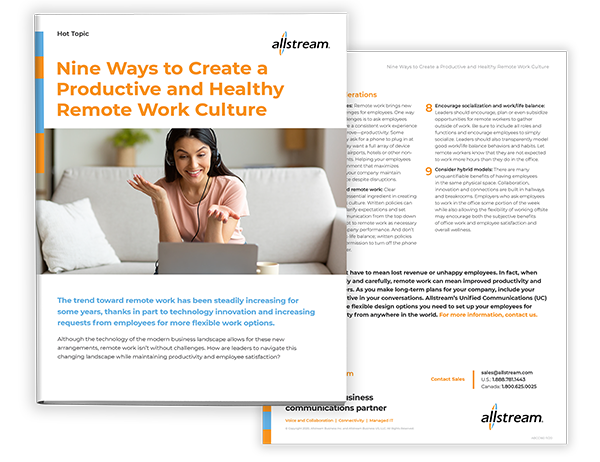Your one-stop spot for all resources to guide your team into the future of work.
Everywhere you look, smart people are talking about the future of work. And it’s true—the pandemic didn’t just accelerate a move to remote and hybrid work, but brought the whole future of work right to our front door. Like the Industrial Revolution and the Information Age before it, the new modern work era promises to usher in changes that will transform work into something we haven’t seen before.
Undoubtedly, this is an exciting time to be alive—at the cusp of new ways and methods of working. But along with the promise of a bold, bright future come questions, concerns and stresses that go far beyond just practical and technological. Indeed, bringing the future of work to your organization means navigating management, productivity, HR and performance questions that you’ve never had to ask before. Where do you begin?
Here’s how to position your organization to thrive in the future of work.
Almost half of professionals surveyed (49%) would turn down a job offer if it required full-time in-office work.
Grow Into the Future of Work
When companies transitioned to work-from-home models in the emergency conditions of 2020, few leaders saw it as a permanent move. Everyone from the top down thought of the remote work conditions as temporary—something that would only last for a few months, at the most, and then business would return to normal.
But as temporary pandemic measures became long-term, the pivot became the status quo. Now, moving into the next phase of work, business leaders aren’t just grappling with questions of hybrid and remote work. They’re also facing questions around a tight labor market, digital transformation and global economic concerns. How can leaders use this next phase of business to propel long-term growth?
As leaders look at the next phase of business, it may be time to re-evaluate some long-term strategies:
Digital transformation initiatives have been broadly on the minds of business leaders for many years, but in order to survive the pandemic, many companies had to accelerate their efforts. In fact, one survey by Twilio found that the COVID-19 pandemic sped up companies’ digital communication strategies by six years.
Of course, the emergency response to the pandemic could have resulted in postponing other initiatives in favor of keeping employees working. Now it’s time to step back and reprioritize. Ask yourself:
- Do you need to improve your call center technology to accommodate at-home workers?
- Can you move more apps to the cloud to help downsize equipment and save money on office space?
- Is there more you can do to protect your network with remote workers in the mix?
- Where does customer experience come into the mix?
- Do you need better apps to interact with customers?
A survey by Twilio found that 97% of enterprise decision makers think the pandemic accelerated their digital transformation.
The move toward increased remote and hybrid work presents some unique opportunities for companies to improve the bottom line through cost reductions. With fewer people in the office and less onsite equipment to maintain, it may make sense to reduce office square footage and shift technology expenses from CapEx models to OpEx models. Cloud-based technology solutions do not require theheavy investment in physical, on-premises equipment that older solutions required.
In addition to cutting costs, the new future of work may allow some companies to improve the bottom line by increasing sales through better customer experience. A variety of digital innovations can make it easier for customers to do business with companies that adopt them.
For many leaders, a top concern in the future of work is how the new models will influence company culture. There’s a significant tension between giving people more flexible work options and maintaining a cohesive culture. When team members are scattered across a variety of functions, geographies and time zones, leaders can struggle to keep everyone focused on the same strategic goals.
The shift to new work models is still very much in flux, and there are few concrete answers for leaders about how to maintain a cohesive culture in the midst of the shift. But as the dust settles in this new work environment, there are some suggestions that may help maintain culture and keep people focused in the same direction:
- Communicate, communicate, communicate: From e-mail to remote company meetings to posts on internal communication boards, leaders need to communicate with relevant, transparent information as often as possible. The clearer and more open they can be about vision, goals, strategies and initiatives, the more likely they are to keep team members engaged and excited about the company.
- Keep the channels open in both directions: Move from an “open door” policy to an “open line” or “open Webex” policy. Make it clear that just because more people are remote does not mean the channels of communication are closed or only work one way. Team members should feel empowered to communicate with leaders in multiple ways.
- Engage in branding and culture exercises: As you conduct employee surveys, collect feedback in a way that helps define the new culture going forward. How does that culture fit into your overall strategy and goals? Don’t neglect branding; at its most basic, a company’s brand reflects its culture and personality. Use those exercises to build a story around your company and communicate it to customers, partners and employees.

As employees look for more flexible work options, technology innovation is steadily increasing. Leaders must navigate this changing landscape while maintaining productivity and employee satisfaction, creating a seamless connection.
Business Continuity and Security in the Future of Work
As important as strategy and culture are to the future of work, those broader initiatives will fail if they aren’t built on a solid technology foundation. From connectivity to networking to communications to security, it’s more important than ever to make sure that your technology foundation has all of the building blocks you need to support your long-term strategy.
Here are some considerations for building the right foundation for the future of work:
There’s no question that giving employees the ability to work remotely during lockdowns saved many companies from dissolution in 2020. But on the other side of the crisis, and with these new models and new information in hand, it’s a good time to look at how to improve business continuity beyond just an emergency plan for the physical office. Keeping business moving in the middle of unexpected situations involves a lot of different pieces. It’s a good time to make sure your entire business is set up to weather unexpected events as much as possible.
Take a look at:
- Production and warehouse: Do you have a storehouse of raw materials for manufacturing? Do you have multiple warehouses that can help each other in the event of supply chain problems? Do all of those functions have the technology to back each other up?
- Sales and sales support: Do you have the infrastructure to support your sales staff from anywhere? Can customers always reach you on multiple channels (phone, text, chat, etc.)?
- Technology: Are you using mostly cloud-based apps and software? If not, are you transitioning to cloud-based systems? Does your network have redundancies and failovers built in to ensure your team is always connected?
As teams become more dispersed in the future of work, it’s more important than ever to make sure that your company has the infrastructure to support people wherever they are. Connectivity and cloud-based applications are the keys to supporting the entire team.
- Communication platform: A cloud-based communication platform offers far more remote work options and ensures better business continuity than a premise-based platform. In the event of a disruption, in-office or hybrid employees can transition to remote work easily and quickly, allowing them to get set up and stay connected to the business almost instantly instead of waiting days or weeks for the right equipment. And with a cloud-based platform, remote employees can connect from anywhere, on any device.
- Connectivity: Whether employees are working in the office or remotely, everyone from sales to HR to warehouse to customer support will need robust, reliable access to the Internet. The future of work is cloud-based, and that means Internet connectivity is more important than ever. It may be time to improve your Internet at the office with Dedicated Internet Access, or you may need a direct connection to your cloud service provider. You may also need to support remote workers by offering financial assistance for improved Internet access to their homes.
- Conferencing and collaboration tools: The future of work will require tools that keep teams connected for work that goes beyond phone calls and e-mail. With the right conferencing platform and collaboration apps, teams can be even more productive than they were in the office. The best conferencing platforms will have end-to-end encryption, integrated collaboration tools and devices, and technology that creates a top-notch user experience. Collaboration is about more than just meetings. From internal chat to shared drives, remote workers need tools that allow them to truly engage in real time with team members across functions, roles and time zones.
A survey of 300 enterprise executives found that 68% believe that employee productivity improved since the move to remote work. – Omdia
For IT professionals, the move into the future of work comes with concerns and questions about how to ensure both security and network performance. With teams working from a wide variety of locations and apps located in the cloud, IT teams need tools to support productivity and ensure security.
- Network prioritization: With employees working from home, Internet access and bandwidth could be shared with any number of devices across the household—some less of a priority than others. With services such as SD-WAN, IT teams can write QoS (quality of service) rules and deploy to the entire remote organization to prioritize business critical applications, giving less bandwidth to streaming services and games.
- Security options: From VPNs to content filters, security has to be top-of-mind for companies equipping remote workers. Remote workers may deal with private customer information or company data, and companies need to know that connections are as secure as they would be in the office.
eBook: Positioning Your Business for the Future of Work with Cloud Communications
Putting People First in the Future of Work
Ultimately, the key to successful long-term growth in the future of work is people. But even as leaders consider strategies for success going forward and IT professionals implement the technology solutions to support people and initiatives, workers everywhere are realizing that they have more power than ever before. In what has been called the Great Resignation, employees are leaving positions in droves. There are a number of reasons for this phenomenon, but the result is a talent shortage that leaves companies competing for an increasingly limited supply of workers.
To stand out from the competition, leaders and companies need to foster a culture that puts people first. The future of work means creating an environment where people can thrive professionally and personally—however they define that.
After months of working from home, workers increasingly report that they are unwilling to pursue a position with any company that requires them to work full-time in the office. As leaders and employees start to think more creatively about work and technology continues to improve efficiencies, hybrid positions will likely extend to formerly in-person only jobs.
But even after the sudden switch in 2020, hybrid work will likely require some adjustment. Some leaders may still have a picture of work as a place, not an action. And long-term hybrid models will require long-term policies. As you strategize and plan for the future of work, consider the following questions in your planning:
- How can we expand hybrid or flexible work options to traditional in-person positions?
- What do our employees say they want in a work model?
- How can we measure performance and productivity in the future of work? What metrics will we use that accommodate new models?
- What kind of IT policies and services will best support remote work?
A Korn Ferry survey found that 89% of professionals are suffering from burnout; 81% feel more burned out now than before the pandemic.
As popular as work-from-home and hybrid models are for professionals, many report significant levels of burnout. In addition, in-person workers may likely feel overworked and unappreciated; in fact, some industries, such as hospitality, are struggling to restaff as the demand for services returns.
The future of work requires leaders and HR professionals to think differently about work, productivity and performance. It may be time to refine policies to take some of the following new realities into consideration:
- Family and home obligations: Many employees may have responsibilities at home that preclude them from working traditional “office hours.” In addition, in-person employees may need a new level of flexibility to accommodate home obligations. Be willing to think about work as an action, not a place, and try to offer flexibility for positions that need to be in person.
- Gig economy: The pandemic has seen a huge rise in self-employed, freelance and “gig” workers. Those workers enjoy the work-life balance and flexibility their models offer, and they may have no interest in permanent employment. To capture their talents, it may make sense to shift some formerly permanent positions to contract or temporary ones.
- Performance management: It may be time to use new metrics for performance management as teams become more ad hoc and work becomes more project-based. Some of the old ways of measuring performance may need to adapt to offer a better, more holistic assessment of team members.
With these changes in mind, employee retention becomes a greater challenge than ever before. To stay competitive in the talent marketplace, companies will have to think creatively about how work is done. To improve employee engagement and retention, survey your team members regularly, and listen to what they want. Flexibility and creative work models will rapidly become a differentiator between companies who keep the best talent and companies who are always searching.
The Allstream Advantage
At Allstream, we’ve been putting people first since our founding, connecting people across geographies and enabling communication across boundaries. What started with the telegraph has evolved into our modern Intelligent Platform that gives you a solid foundation to support your long-term growth.
Allstream has deep roots and a longstanding history of equipping our customers with the tools they need to be productive and remain connected across multiple locations. Our depth and breadth of experience means that your employees get a consistent communications experience, whether they are working in the corporate or home office.
Allstream offers a complete cloud telecommunications solution, partnering with industry-leading providers Cisco and Mitel. We have the experience to implement a configuration that works for your remote team.
Our solutions give leaders the tools they need to allow employees to work from anywhere, on any device, while still providing an excellent customer experience. With a customized remote work solution, you can improve employee satisfaction, meet customer demands, and remain flexible in the face of disruption.
As a total solutions provider, Allstream can provide the remote work options that are right for you and your team, wherever you are in your journey. With our expertise, you can take care of all your essential telecom services in one place.
Here are a few features to look for:
- Expertise in telecommunications
- Integration with your other software solutions (open API)
- Current and future artificial intelligence (AI) capabilities
- Flexibility and efficiency
- Advanced capabilities for insights and metrics
- Hyper personalized experiences with enhanced, easy-to-use self-serve options
- Predictive analytics
- Supervisory dashboards and reporting
- Ongoing support and service
- Remote Contact Center Solutions
An experienced solution provider will take the time to evaluate your unique needs and situation.
Typically, you’ll be asked to join a personalized “discovery call,” where an expert can answer your questions, assess your needs and propose a solution that works for your business.
- Insights for managers: Provide your managers with real-time information about how your employees are using remote work tools
- Flexibility and adaptability: Work and collaborate from anywhere, on any device
- Budget control: By leveraging all or part of an OpEx model, you can eliminate potential surprises related to legacy or on-premise components
Whether you have a small team or thousands of employees, Allstream has experience working with businesses of all sizes. We are big enough to deliver—small enough to care.
Contact us today to learn how we can help your business.
Do you want to position your company for long-term success? Learn why you must adopt communication and collaboration strategies that include stable and secure web and video conferencing.
Ready to get started? Explore Allstream’s array of remote work solutions.
Call Sales at 1-833-603-6600, or let us know more about your needs and an Allstream expert will be in touch. Our experienced representatives can make a personalized recommendation for you, based on your business’ specific situation and requirements.





